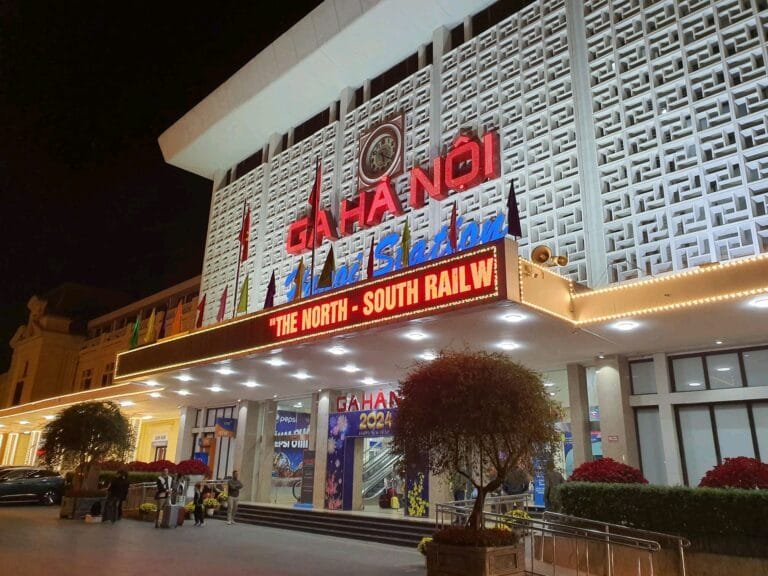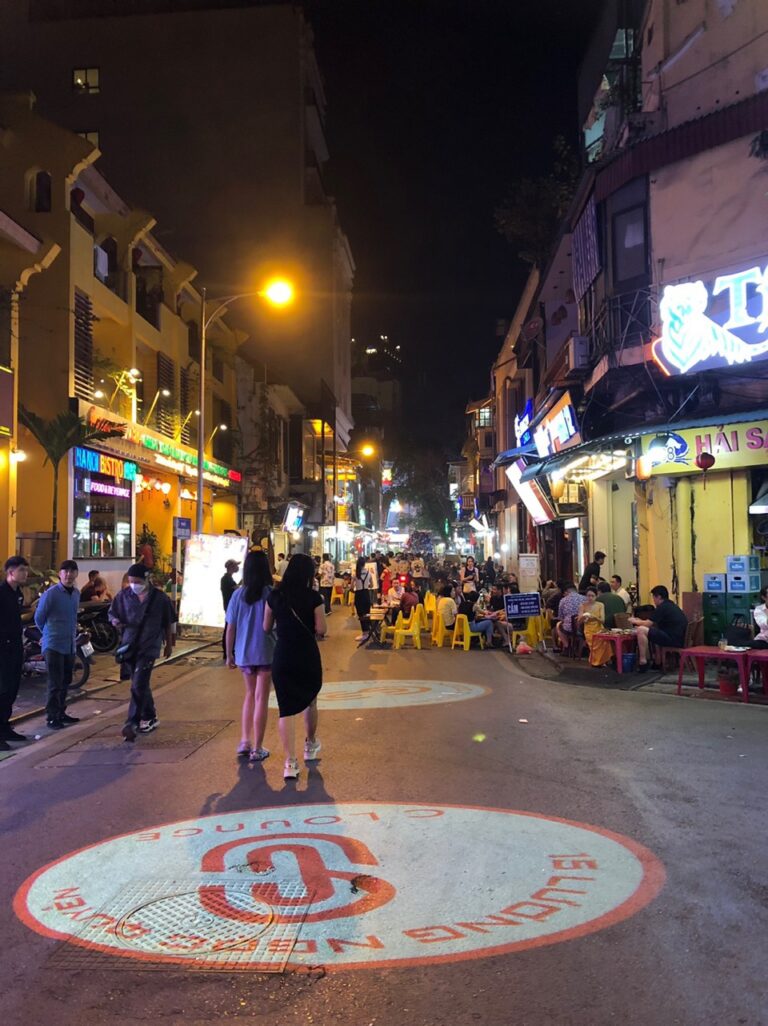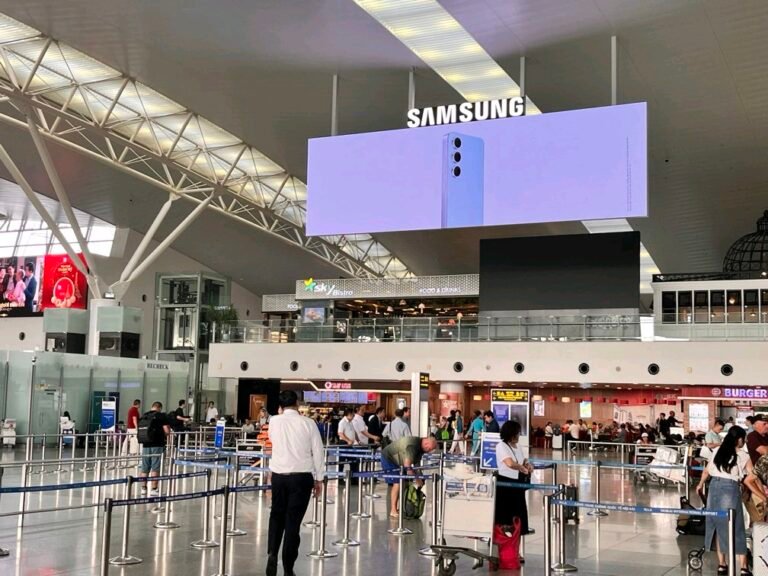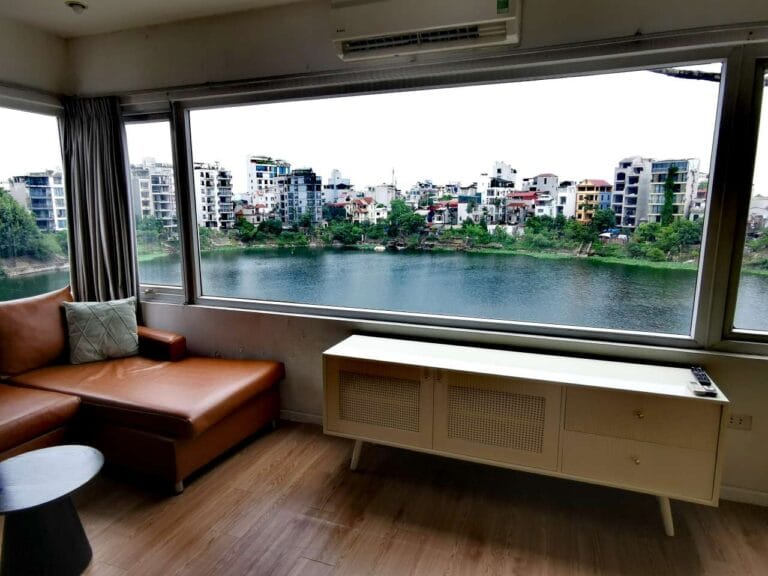Hanoi Travel Guide: 16 Best Things to Do, Transport Tips, and Must-See Attractions

Wondering if Hanoi is worth visiting ? Absolutely! This Hanoi Travel Guide covers everything tourists need to know—from how to get there and where to stay, to must-see attractions, local experiences, and transportation tips.
Overview: Hanoi Travel Guide
I think the first thing that strikes you when you first step into Hanoi is that you have to be careful where you put them! This Hanoi Travel Guide aims to help you avoid those small suprises, and this Hanoi Travel Guide makes navigating that chaos a lot easier.
Hanoi is somewhat like Ho Chi Minh in terms of the joyful mess of scooters but with narrower streets. This city that never sleeps left me a bit repelled: too much noise, too many horns, too many people. But it still has some nice surprises!
Top 9 Vietnamese Food Spots in Hanoi: Culinary Secrets Revealed
HOW TO GET THERE
There are not 10,000 of ways to get to Hanoi, but 3 ways: plane, train, or bus!


NOI BAI AIRPORT
Whether you arrive by domestic or international flight, you will arrive at the city’s only airport, Noi Bai International Airport, located just north of Hanoi. It is about 30kms away from the city centre.
It should be noted that from India, flights into Hanoi are on average reasonably inexpensive from India.
Hanoi Noi Bai Airport Guide 2025: Arrival Process, Transport, SIM Cards & Travel Tips
A Delhi-Hanoi ticket costs between 200 US dollars on average. To pay less for your tickets, it is best to book them well in advance.
Find a flight to Hanoi.
Best SIM and eSIM in Hanoi, Vietnam (2025 Guide: Viettel, Vinaphone, Airalo & More)
Noi Bai Airport is located 30 km from the center of Hanoi. To reach Hoan Kiem (city center or old town), you have any of the following options:
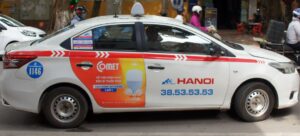

Take a taxi: count on 400,000-500,000 dongs for a ride to Hoan Kiem. Beware of the scams mentioned below!
GET TO CITY CENTER
Take a bus: Bus line 86 leaves every 20 minutes to take you to the center. Its terminus is Hanoi Train Station, on the edge of Hoan Kiem. If you have any doubts about your stop, ask the driver, he speaks English! Count on 35,000 dongs per person.


Take a shuttle from the airlines: Vietjet Air and Vietnam Airlines have set up shuttle systems to the center for 40,000 dongs, even if you haven’t traveled with them. You can’t miss them at the exit of the terminal, they are so colorful.
Hanoi Airport to Old Quarter: All Convenient Transport Options Compared (2025)
As you can see, taking a taxi from the airport to the center of Hanoi is not the best solution economically. Buses and shuttles are well-equipped and cheap too!
Warning: If you have booked a hotel in Hanoi, the hotel may offer to pick you up at the airport, often for around 20 dollars, or 500 000 dongs. You can even say that the price is a bit high and there is an alternative .
Complete 3-day Hanoi Itinerary, Vietnam (Beginner Friendly Guide)
GETTING TO HANOI FROM NEARBY CITIES
TRAIN TO HANOI
If you are already in Vietnam, you can come by train or bus from Sapa, Ninh Binh, Dong Hoi, or Hue.
The good news: the train station (Ga Ha Noi) is located in the center of Hanoi, on the edge of the Hoan Kiem district! From there, you can take a taxi or walk, depending on the location of your hotel.


If you are coming from the south of Vietnam, there is a good chance that you will arrive at Giap Bat Bus Station, located in the south of Hanoi.
The My Dinh Bus Station, located west of the Vietnamese capital, mainly serves northern cities (Mai Chau, Lai Cao, Cao Bang).
Finally, the bus station of Gia Lam, located northeast of Hanoi, is home to eastbound buses that go to Halong Bay. Since they are quite far away, you will have to take a taxi or a bus to reach downtown Hanoi.
HOW TO GET AROUND
Getting around Hanoi is not an easy task, especially because few detailed maps exists…
This part of the Hanoi Travel Guide should save you some headaches.
3 Best Way to Get Around Hanoi as a Tourist | Grab vs Taxi vs Xe Ôm Guide
Getting around Hanoi by road can sometimes be a bit chaotic! To get from point A to point B, you have about 6 options:
SCOOTERS RENTAL


Well, I put this option because it is possible to rent a scooter in Hanoi. But honestly, unless you have a good dose of Vietnamese blood and courage and a bit of faintness, I don’t see why you would want to do that! For your information, Hanoi (or Ha Noi) has more than 6 million people and almost as many scooters!
But once you arrive in Vietnam, you get used to it quickly and you learn to cross the street! There is no miracle for this, you just have to get started! The first time you feel like doing a kamikaze operation, but in the end, you realize that it (almost always) happens automatically!
TAXI
This is probably the most convenient option, but not the fastest, and especially a trapdoor for scams! We often hear that if a cab agrees to have a meter, we are all fine. Well… this is valid for many Asian cities, but not really in Hanoi.
You should know that many cabs have fake meters! Those who count 800 meters as 1 km, those who apply an ambiguous price list, those who operate normally, and those who dramatically increase the fare by 1 km from the destination…
Not to mention those dishonest drivers who will make you circle the city 18 times before taking you where you want to go, the scams are numerous!
To avoid being cheated, activate the GPS on your phone to see which route you have chosen. If you think the meter is going faster than you would like, change cabs! Some big companies like Mai Linh (Green Cab) are considered more accurate. Yes, to be proven!


BIKE TAXI
You will notice that you will not be 3 meters away from your hotel when someone has already approached you: “Sir! Motorcycle?”. If you refuse, do not be surprised by the offer of other services (marijuana, girls).
But let’s leave aside the many aspects of this profession and get back to the initial idea: getting around Hanoi! The motorcycle is probably the fastest way to get around.
However, it is also an opportunity for Westerners to test their heart’s capacity! Slaloms between cars, red lights, driving in the wrong direction, and even walking on the sidewalk if the road is too busy are all part of the ride! In short, give it a try but honestly, I’m not a fan of it!
Buses exist. It’s cheap but sometimes confusing. Not tourist-friendly as no one understand English in Public Buses.


PUBLIC BUS
If you want to travel by bus in Hanoi it is not very easy, because there are so many lines. It is also not easy due to the lack of signs at the stops and especially maps. But if I had to mention just one useful line, it would be bus line 34. It connects the bus stations of Gia Lam and My Dinh, passing through the old district.
Be prepared, though: the bus is probably the slowest way to get around in Hanoi due to the heavy traffic! But it is the cheapest: a ticket costs between 3000 and 5000 dong, depending on the line!
Checkout our Hanoi Public Transport Guide below:
Guide for Public Transport in Hanoi, Vietnam (Buses, Metro & 2025 Travel Tips)
CYCLOS
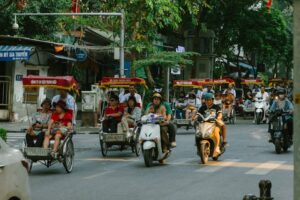

We admit that we preferred walking instead of taking this emblematic means of transport in Hanoi. For 150 000 dong, you will take a 1-hour cyclo tour through Hoan Kiem. Be careful: scams in cycle rickshaws are just as frequent as in cabs, so don’t hesitate to agree on a price before the ride!
On foot!
During our short stop in Hanoi, we did everything on foot, more than 20 kilometers in some days! Besides training to cross streets in kamikaze mode, this way of walking also gives you the chance to fully understand the pulse of the city by crossing several districts. In short, we love it!
ACTIVITIES
TAKE A WALKING TOUR
If you’ve been following us for a while, you know that we are fans of walking tours! The concept? A guide takes you on a walking tour to share all the secrets of the city.
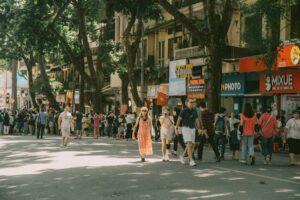

It is a free tour but based on tips. Because of this, the guides are often very motivated and extremely knowledgeable about the city!
Most of the time, we do it at the very beginning of the trip, as we usually leave with a good historical background and lots of ideas for places to visit. Book a walking tour through Hanoi.
WALK ALONG THE LAKESIDE
As you can see, traffic in Hanoi is like a jungle, and you may feel disturbed by all the roaring engines, constant horns, and motorcycle cabs.


So, exploring one of Hanoi’s many parks and lakes is a great way to relax a bit!
Badminton on the sidewalks in Hanoi
However, this is not the most comfortable option: sidewalks in Hanoi are a vague concept, when there are not 30 scooters parked on them blocking your way, it could be an improvised café, a street food stand, a fruit vendor, or even Vietnamese people who have organized a badminton game in the heart of the city.
Finally, in Hanoi, we move mainly on the street. Plus, since the scooters also travel on the sidewalks, it doesn’t change much!
NEIGHBORHOODS
HOAN KIEM LAKE
Hoan Kiem Lake is probably the lake you will see the most if you stay in the Old Quarter and I think it is also the lake with the most character.


It is big enough to get away from the traffic congestion. Also, it is small enough that you can walk around it in less than an hour while stopping for a Vietnamese coffee on a terrace by the lake. It also has the Ngoc Son Temple, a nice little Confucian temple (entrance fee is 30,000 dong).
WEST LAKE
The West Lake is an ancient dead branch of the Red River and the largest lake in Hanoi. Impressive by its size (5 km2), we liked the slightly retro, almost abandoned, aspect at the water’s edge.


We had lunch on one of the boats. Well, the food was bad and the waitress tried to charge us double. So, we don’t recommend it very much, but for a coffee or a Coke in a 100% retro atmosphere, why not?
SIGHTS
BAY MAU LAKE
Bay Mau Lake is not worth seeing, but what is worth seeing is Thong Nhat Park (or Reunification Park) that surrounds it! After crossing the garden door, we find ourselves immersed in an atmosphere that reminds us of a lot of Chinese parks: everyone dances, runs, does fitness, rollerblades, plays badminton, and enjoys a few rays of sunshine that pierce the smoke.


On the other hand, to enter Thong Nhat Park you have to pay an entrance fee of 4000 dong. It’s not expensive, we agree, but we didn’t see any Vietnamese paying. Let’s just assume that it’s a small price to help maintain the park and that it’s not another tourist scam… even if it is a small scam, it’s worth it!
TRAN QUOC PAGODA
On the other hand, the famous Tran Quoc Pagoda is located on Ho Tay Lake. It is not possible to see it, but it is an opportunity to take good photos during the day and at night.


ONE PILLAR PAGODA
Not ugly, but not very pretty either, the One Pillar Pagoda disappoints a bit because of its small size… The same goes for explanations: nothing is described or indicated on the spot…


Fortunately, my friend Wikipedia told me that it is an 11th-century construction! According to legend, it was built by the emperor who must have dreamed of the birth of his son, who was brought to him by a goddess on a lotus flower. When his son was born, he had the pagoda built with a single pillar, symbolizing the blooming of the lotus emerging from the ocean of worries.
Well, the little Chua Dinh Hu temple in front of it also had a few surprises for us.
TEMPLE OF LITERATURE
We promised ourselves we would go there and in the end, it was a little forgotten… This temple, divided into 5 courtyards, was the seat of a Confucian academy aimed at training future scholars.


Today, it is one of the most important monuments in the capital, it is even found on the back of the 100 000 dong banknote. In short, the Temple of Literature is a must-see if you visit Hanoi! It is open every day from 8 am to 5 pm and the entrance ticket costs 30 000 dong per person.
HO CHI MINH MAUSOLEUM
By the way, the Ho Chi Minh Mausoleum is probably a must-see on a trip to Hanoi, but this little tour in the park made us a little hungry. During the walk, we didn’t find a single explanatory sign, except perhaps one that said: “Here is a car that Ho Chi Minh used “, thanks, guys! In short, there was nothing very outstanding.


Our visit to the Ho Chi Minh Museum was probably our most amazing experience in Hanoi. One room after another is filled with “artifacts”, each one more bizarre than the other. They are supposed to abstractly present the history of Ho Chi Minh without any indication.
Sometimes, there was an explanation, but it only confirmed our idea that the creators of the museum must have been on acid when they set up the museum! In the end, we spent more than an hour there and learned nothing about Ho Chi Minh’s life. At least we had fun!
Practical information
The Ho Chi Minh Mausoleum is theoretically open from 8 am to 11 pm, the times often vary! Admission is 25,000 dong, which is about $1, for foreign visitors while Vietnamese citizens entrance is free.
OPERA HOUSE
You can only enter if you attend a concert, but its exterior inspired by the Garnier Opera House is worth a visit!


The Imperial Citadel of Thang Long: Listed as a UNESCO World Heritage Site, the ancient Imperial Citadel reveals its secrets through history and wars. If you are passionate about the history of Vietnam, a visit is a must! The entrance fee is 30 000 dong and the Citadel is open daily from 8 am to 5 pm. Otherwise, you can admire the northern gate of the site and the flag tower to the south.
THANG LONG IMPERIAL CITADEL
The Thang Long Imperial Citadel is a cool place to check out! It’s a UNESCO World Heritage Site, and it spills the tea on history and wars.


If you’re into Vietnamese history, you gotta go! It’s 30,000 dong to get in, and they’re open every day from 8 am to 5 pm. Or you can just stroll around and peep the northern gate and the flag tower in the south.
WATER PUPPET SHOW
It’s always nice to enjoy a bit of kitsch and a classic tourist attraction, so we let ourselves be tempted by the Thang Long water puppet show that is played near Hoan Kiem Lake. After paying for our tickets, we arrived at the performance hall, which was surprisingly full of tourists who had come to experience this art.


The art of water puppetry has its origins in northern Vietnam. The concept is very simple: puppets are mounted on bamboo rods and animated on the water from behind the stage. We would love to tell you more about the mechanism, but apparently, it’s 100% top-secret art!
9 Helpful Cultural Etiquette in Hanoi: Do’s and Don’ts for Foreign Visitors
This show aims to perform various fables and myths from Vietnamese history through puppets, and all this will be accompanied by traditional music.
We enjoyed the show a lot, especially because during the show live music is played by musicians and the story is told by a singer. By the way, in Vietnamese, so we didn’t understand much, but that’s not the point! In the end, it was such a gift for the eyes and ears that lasts for an hour and it would be a shame to miss it!
Practical information for Water Puppet Show
Tickets for the water puppet show cost up to 100 000 dong per person for the cheapest seats and 200 000 dong for the first 5 rows. Be careful, there is a sign at the entrance that you have to pay for pictures, but nobody pays.
Just ignore that sign and keep the 50,000 dong charged to buy yourself a beer on your way out. Performances take place at 4.10 pm, 5.20 pm, 6.30 pm and 8 pm. Tickets are available at the venue, but it is possible to buy tickets online through GetYourGuide. The price is a little higher, but it guarantees you a seat. In high season, this water puppet show is quite popular!
MUSEUMS
Like any big city, Hanoi has many museums. To be honest, their quality varies a lot! Here’s a small overview of the museums we visited and what we thought of them.
VIETNAM ETHNOLOGY MUSEUM
If you are interested in the culture and history of Vietnam’s ethnic minorities, don’t miss this museum under any circumstances! In fact, it’s not only a museum exhibiting many objects coming from different ethnic groups, but it’s also a huge park with houses reproduced exactly!


The explanations given in English throughout the tour are detailed and interesting! Some advice: go there alone to avoid any organized tour and without time restrictions! We spent more than 3 hours there and didn’t read everything! Some guides allowed their groups to stay 40 minutes in the museum and 20 minutes in the park. we were a bit worried for them!
The Ethnology Museum of Vietnam is open every day from 8:30 am to 5:30 pm, except Mondays. Tickets cost 40 000 dong per person. To get there from the city center (Hoan Kiem):
Bus line 14 which runs north of Hoan Kiem Lake stops nearby (Nghia Tan stop). The bus ticket costs 5000 dong.
By taxi, a trip from Hoan Kiem will cost around 130,000 dongs.
HOA LO PRISON RELIC
Hoa Lo Prison was built by the French in the late 19th century. During the Vietnam War, the prison was used as a detention center for U.S soldiers and generals, including Senator John McCain. At that time, the prison got the nickname “Hanoi Hilton” from the hotel chain, which is completely ironic, since Hoa Lo was a place where American soldiers were interrogated to extract confessions.


But during our visit, we realized that the Vietnamese people had another meaning for the nickname… In the exhibition, we can see photos of American soldiers walking freely around the prison, playing football and cards, and enjoying bottles of red wine. In all the photos, the soldiers are smiling, playing with children, and almost seem to be at summer camp.
Also read: Hoa Lo Prison Museum: History & Travel Tips
Hoa Lo Prison is open every day from 8 am to 5 pm. The entrance fee is 30 000 dongs and you can rent an audioguide for 100 000 dongs. We went there on foot, it’s about a 10-minute walk from Hoan Kiem.
WOMEN’S MUSEUM
This is probably the museum in Hanoi where we spent the most time! The Vietnam Women’s Museum is spread over 5 floors and traces the lives of Vietnamese women over time, but also according to different ethnic minorities.


We found the museum very well maintained and well documented, with many explanations available in English.
The Vietnam Women’s Museum is open every day from 8 am to 5 pm. The entrance ticket costs 40 000 dongs and you can rent an audio guide for 40,000 dongs. In our opinion, it is best to get there on foot, as it is close to the city center, Hoan Kiem.
STREET FOOD OF HANOI
Hanoi is a foodie paradise. Street food, Cafes and traditional restaurants. It’s cheap, delicious and authentic. You’ll eat like a king. For pennies. Let’s talk food.
Phở. Vietnam’s famous noodle soup that is served with Beef or chicken. Slurpy goodness. Try Phở Gia Truyền. Old Quarter. $2 a bowl. Bun Cha is grilled pork with noodles, fresh herbs.
Hidden Street Foods in Hanoi That Locals Don’t Want You to Find
Bun Cha Huong Lien is where Obama ate. Famous egg coffee is Hanoi’s specialty. Creamy and sweet. Cafe Giang is the place to try the authentic $1 a cup.
Where Bun Cha in Hanoi Tastes Best – Obama’s Table and Beyond
Banh Mi, Baguette sandwiches. Paté. It have ingredients like veggies, meat and different kind of sauces. Banh Mi 25 is legendary place to try Banh Mi. You may get long lines but it worth to wait for few minutes.
Cha Ca — Hanoi’s smoky grilled fish masterpiece, served with dill, rice noodles, and crunchy peanuts. Head to Cha Ca Thang Long and see why one happy traveler swore, “Best meal of my life.”
INDIAN RESTAURANT
Kadhai Indian Restaurant. Hoan Kiem. Craving curry? Go here. 4.9 stars. Butter Chicken, Naan and all the authentic dishes with the same flavors you get like eating in India.
Top 8 Irresistible Indian Restaurants in Hanoi, Vietnam You Just Can’t Miss
CAFES
Hanoi’s cafe scene is insane. “Cong Caphe” have best Coconut coffee. Another famous cafe in front of Hoan Kiem lake is “The Note Coffee”. Walls covered in sticky notes. Quirky. Fun. Cafe Dinh. Retro vibes. Hidden gem. Great views. Egg coffee heaven.
18 Best Hanoi Cafes in 2025: Extraordinary Egg Coffee, Cozy Corners & Instagram Gems
PRO TIP: Eat where locals eat. Crowded spots? Usually best and don’t forget to carry cash. Small bills that’s the reason- Street stalls don’t take cards. Food tours? Awesome. Tour Guides show you hidden gems for about $25 but worth it.
HANOI NIGHTLIFE
Hanoi’s got a pulse and Old Quarter is the spot. “Bia Hoi,” the famous name for Hanoi’s fresh beer. It is just 25 cents a glass with sidewalk stools to sit on. Locals and tourists mix at Ta Hien Street- “Beer Street.” It has bars, live music, crowded on weekends but fun.
Is Hanoi Safe at Night | Safety Tips for Women Traveling Alone in Hanoi
Want chill? Rooftop bars like Skyline Hanoi. Stunning views with best cocktails. It is not cheap but memorable. Night markets too. Dong Xuan market and the famous weekend market of Old Quarter have so much to shop and eat.
ACCOMMODATIONS
It’s very easy to find accommodation in Hanoi because hotels are sprouting like mushrooms and there’s something for every budget! However, the most popular area for travelers is the old Hoan Kiem district, and, of course, you’ll have no trouble finding a hotel or youth hostel there!
MID-RANGE HOTELS
Boutique hotels. $20-$50. La Siesta Hotel. Old Quarter gem. Cozy. Great service. Breakfast included. Apricot Hotel. Near Hoan Kiem Lake. Artsy vibe. Rooftop bar. Tripadvisor loves it. 4.5 stars.
LUXURY STAYS
Sofitel Legend Metropole is iconic looks like a french colonial era hotel. $200+ a night, but it’s worth it. Celebrities stay here or InterContinental Westlake. It’s modern have lakeside view.
Pro tip: Book early. Hanoi peak season is November to April as it is a dry season so prices spike in those times. Airbnb is an option too. Apartments in Tay Ho or Old Quarter have local vibe and you can get good deals.
We stayed at the Golden Lotus 3 star Hotel. In our opinion, it was a good choice, because, for $15 per night, we got a great room with great WiFi (the best since the beginning of the trip!). But other than that, most hotels in the area are between $12 and $25 per night for a standard double room with bathroom and hot water. To get the best price, it’s best to book directly on the spot. The prices offered on booking websites are often higher.
ADDITIONAL TIPS
- Visa: Check requirements. Many need e-visas. Easy online. $25. Apply early.
- Money: Vietnamese Dong. ATMs everywhere. Cards work in hotels. Restaurants. Cash for markets. Stalls. Exchange at banks. Better rates.
- Language: Vietnamese. Hard to learn. English common in tourist areas. Learn “thank you” (cảm ơn). Locals love it.
- Safety: Hanoi’s safe. Pickpockets in crowds. Watch your bag. Scams? Rare. But haggle taxi fares. Use Grab to avoid rip-offs.
- Internet: Wi-Fi everywhere. Hotels. Cafes. Even street stalls. 4G SIMs. Cheap. Viettel. Mobifone. $5 for 1GB daily.
- Health: Street food’s safe. If busy. Bottled water only. Tap water’s a no. Mosquitoes? Use repellent. Dengue’s rare. But real.
CHALLENGES
Hanoi’s not perfect, and this Hanoi Travel Guide won’t sugarcoat it. Traffic’s nuts. Crossing streets? Scary at first. Practice makes perfect. Pollution’s an issue. Masks help. Sidewalks? Cluttered. Motorbikes park there. Walk carefully. Noise? Constant. Honking. Construction. Bring earplugs. If sensitive.
Scams? Not common. But watch out. Overpriced taxis. Fake tours. Book through reputable sites. Viator. GetYourGuide. You’re fine. Language barrier? Sometimes. Google Translate helps. Locals are patient. Smile. You’ll manage. Most of these issues are the small, predictable challenges every Hanoi Travel Guide warns you about.
CONCLUSION
Hanoi is definitely a great travel destination for tourists. Its rich historical and cultural heritage, charming old streets will give you a unique experience. If you want to see the blend of history, culture, and modernity, then Hanoi is an ideal place for you.
Hanoi is definitely a great travel destination for tourists. Its rich historical and cultural heritage, charming old streets will give you a unique experience. If you want to see the blend of history, culture, and modernity, then Hanoi is an ideal place for you.
Read more: Hanoi Food Guide


